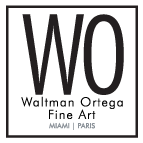“I have always liked to arrange, to divert objects from their familiar, everyday usage.
At the institute of art of Aix-en-Provence I had a certain affinity with the perceptions of Marcel Duchamp who already in 1910 wanted to disengage himself from the «tyranny of painting». At the same time he was rather disquieting when he asserted that «pleasure does not have its place in art». Even now-a-days his numerous imitators continue to reject technical proficiency and proclaim the death of art. If there is no pleasure, no demand for savoir faire’, and furthermore that art is on the decline, why would one aspire to be an artist?
Hazard, the “Grand Master”, orients me towards a company of micro processing then one of software development. There I uncover unexpected, fertile domains, profitable for artistic creation. Few were the artists in the eighties who integrated the world of data-processing. They limited their endeavors solely to the graphic use of the machines. When we discussed it, they seemed to perceive data-processing as about exciting as its beige color. It was necessary to begin to work at using this new technique in another manner…
With the auspicious initiative of Fernand Braudel, the Maison des Sciences de l’Homme invites me to make my first exhibition of ‘Luchrones’ in 1984. The sculptures are of small stature and their conception is founded on the idea of amalgamating light with the dynamics of Time. The electronic components, even the structure of the logical circuits, are at the origin of the forms – of the bursts of light that travel over the entwining lines.
It’s public art which occupies me for the next few years. In 1986, the first monumental Luchrone lights up at Bourges. Where it continues to glitter. Three years later the city of Reims commands ‘la Coquille’. I’ve changed the dimensions of the works which are four to six meters high. I can even move around inside!
Accustomed now to the large-scale models of four meters in diameter, I realize the Astrolabes of Val-de-Reuil (1990), Reims (1991) and Paris (1997). The light of the stars draws my particular attention. (An attraction witch I’ve had since my earliest childhood.) I make the acquaintance of astronomers, who like artists are personages on the marge of society, remaining aloof from the dictates of suffocating consumerism.
The years passed on weighty projects make me realize to what point I miss the lightness and inventiveness of the Luchrones…”
Alain Le Boucher
“The touch of chance. In the sound domain, chance produces “white noise” which is the background noise of magnetic tapes. In the field of colors, chance will give the color gray, which unites all the others. Nothing very interesting then, if the chance remains abandoned to itself.
Chance can, however, be confronted with rules and constraints. This will be for example the numbered wheel of the wheel on which the ball will land.
Rules and constraints are essential to allow chance to manifest itself in our eyes. The luminous scores that I have written are suites of possibilities. By precisely following the rules that I have given, chance will combine rhythmic and shapes with light intensities over time. ”
“Since Leonardo da Vinci, painting has always considered itself as ‘cosa Mental’. And this despite its deeply artisanal aspect. On the contrary, sculpture seemed, of all the arts, the most definitely linked to matter. This is what I believed until computer science showed me the possibility of working with light itself. The nuances and rhythms of light are – like sound – in direct continuity with the computer systems that control signs or shows. The particular aesthetic of electronics: labyrintic circuits and tiny components is always hidden from view. Television, telephones no more than cars show the components that drive them. Is it not to scare us? The tiny mechanisms where dazzling calculations are carried out are still hidden. ”
